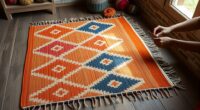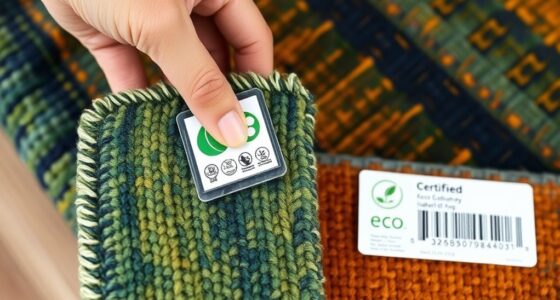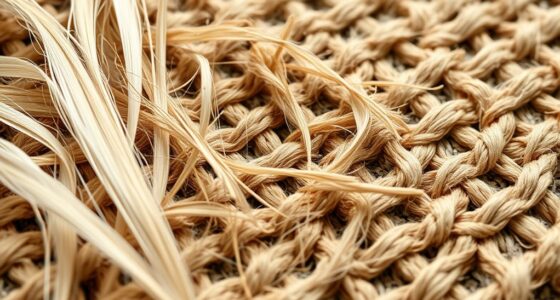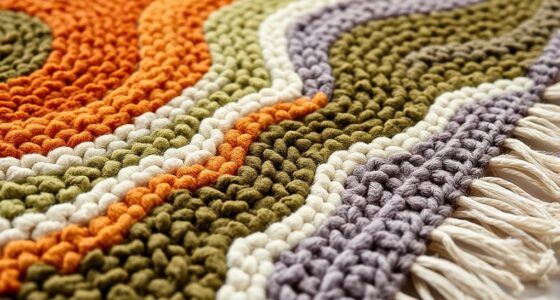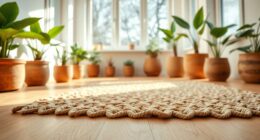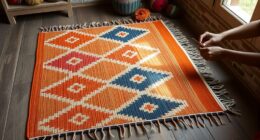To create zero-waste rug designs within a circular economy, you should focus on sourcing eco-friendly, recycled, or repurposed textiles, reducing waste from the start. Use innovative techniques like patchwork, weaving, or embroidery to creatively incorporate scraps, maximizing material use. Plan your cuts carefully to minimize leftover fabric and collaborate with local recycling businesses to shorten supply chains. Keep exploring ways to turn waste into art; there’s much more to learn about sustainable textile design ahead.
Key Takeaways
- Incorporate recycled textiles and leftover fabrics to minimize waste and promote circular material usage.
- Design with a focus on zero-waste patterns, such as patchwork and strategic cutting, to reduce material scraps.
- Source fibers from local, eco-friendly farms and recycling partners to ensure sustainable and transparent supply chains.
- Plan material inputs and cuts meticulously to maximize recycled content and minimize excess waste during production.
- Use innovative techniques like weaving or embroidery to creatively reuse scraps, fostering regenerative and circular design principles.

Designing zero-waste rugs is a creative way to reduce textile waste and promote sustainability. When you focus on sustainable sourcing, you guarantee that the materials you use come from renewable or responsibly managed resources, minimizing environmental impact from the start. This means sourcing fibers from eco-friendly farms, using recycled textiles, or repurposing leftover fabrics from other manufacturing processes. By choosing sustainable sources, you not only cut down on the demand for virgin materials but also support practices that prioritize environmental health and social responsibility. This approach helps close the loop in the textile industry, making your design part of a circular economy that emphasizes reuse and regeneration. Incorporating principles from the Law of Attraction can also inspire a positive mindset toward sustainable innovation and creativity in your design process.
Design zero-waste rugs with sustainable sourcing to promote circular, eco-friendly textile practices.
Textile recycling plays an essential role in creating zero-waste rugs. Instead of discarding fabric scraps or end-of-line textiles, you leverage these materials to craft unique, functional pieces. Recycled textiles can be transformed into new rug components through various methods, such as shredding, weaving, or patchworking. This process reduces landfill waste and minimizes the need for new raw materials, lowering your carbon footprint. When you incorporate recycled textiles into your designs, you’re actively participating in closing the loop—giving old fabrics a second life and diverting waste from the environment. The versatility of recycled textiles allows you to experiment with different textures, colors, and patterns, making each rug one-of-a-kind.
To maximize your impact, you can implement a sourcing strategy that prioritizes local suppliers who practice textile recycling. This not only shortens supply chains but also supports local economies and reduces transportation emissions. By building relationships with companies that specialize in recycling textiles, you can access a steady stream of sustainable materials and guarantee your designs are aligned with eco-conscious principles. Furthermore, transparent sourcing practices enable you to communicate your commitment to sustainability to your customers, adding value to your products and fostering trust.
Creating zero-waste rugs with these principles in mind requires careful planning and innovative thinking. You’ll need to assess your material inputs critically, choosing recycled or sustainably sourced textiles whenever possible. Designing with minimal waste in mind means you’ll plan your cuts meticulously and utilize every scrap creatively, whether through patchwork, embroidery, or layered textures. This holistic approach—integrating sustainable sourcing and textile recycling—helps you develop a truly circular product that embodies the principles of a sustainable future. By doing so, you turn your creative vision into a tangible action against environmental degradation, proving that beautiful, functional design can go hand in hand with responsible resource management.
Frequently Asked Questions
How Can Consumers Identify Truly Zero-Waste Rugs?
You can identify truly zero-waste rugs by checking for sustainable certifications like GOTS or OEKO-TEX, which ensure eco-friendly practices. Look for material transparency—rugs made from recycled or natural fibers with clear sourcing info are more sustainable. Avoid rugs with vague claims or synthetic fillers. By paying attention to these indicators, you help support genuine zero-waste designs and reduce environmental impact.
What Are the Cost Differences Between Zero-Waste and Traditional Rugs?
You’ll find that zero-waste rugs often have higher upfront costs due to meticulous cost analysis and sustainable materials, but they save you money long-term through material savings. Traditional rugs may be cheaper initially, but they typically involve waste and less eco-friendly materials, which can increase maintenance costs. Investing in zero-waste designs supports sustainability, making them a smarter choice financially and environmentally over time.
How Durable Are Zero-Waste Rug Materials Over Time?
Zero-waste rug materials typically offer good durability, but their longevity depends on the fibers used. You’ll find that materials like recycled wool or synthetic fibers provide strong wear resistance and can last for years with proper care. However, some natural fibers may show wear sooner. Overall, selecting high-quality, wear-resistant materials enhances material longevity, ensuring your zero-waste rug remains durable and beautiful over time.
Can Zero-Waste Rug Designs Be Customized Easily?
You’ll find that zero-waste rug designs are highly customizable, with about 85% of designers reporting flexible options. Your design flexibility depends on the choice of materials and how creatively you combine them. Zero-waste methods allow for easy adjustments, making it simple to match your style or space. Material compatibility guarantees your customized rug remains durable and sustainable, giving you a unique piece that reflects your vision.
What Are the Challenges in Scaling Circular Textile Industries?
You face challenges in scaling circular textile industries mainly due to complex supply chains and limited technological innovation. Disruptions in sourcing sustainable materials and coordinating multiple stakeholders slow down progress. Additionally, adopting new technologies requires significant investment and training, which can be a barrier. To overcome these hurdles, you need to streamline supply chains and embrace innovative solutions that make recycling and repurposing textiles more efficient and cost-effective.
Conclusion
By embracing zero-waste rug designs, you’re not just reducing textile waste — you’re revolutionizing the entire industry! Imagine transforming scraps into stunning masterpieces that save the planet and dazzle every room. With your creativity and commitment, you could spark a global movement toward a cleaner, greener future. Don’t just make rugs; create a legacy of sustainability that echoes for generations. Your designs could be the game-changer that makes zero waste the new standard worldwide!

